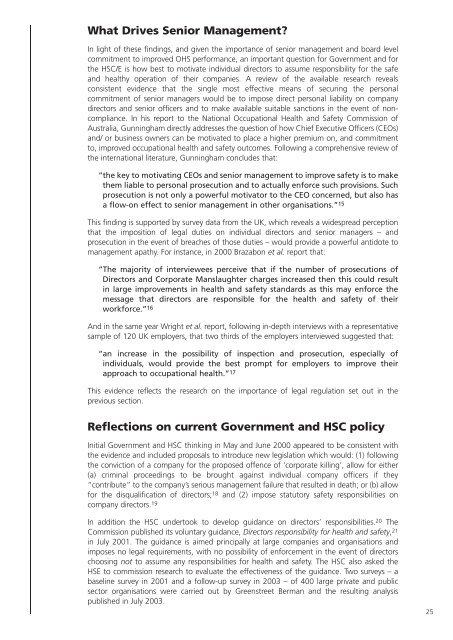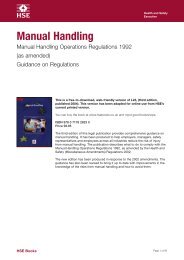Making Companies Safe - what works? (CCA ... - Unite the Union
Making Companies Safe - what works? (CCA ... - Unite the Union
Making Companies Safe - what works? (CCA ... - Unite the Union
You also want an ePaper? Increase the reach of your titles
YUMPU automatically turns print PDFs into web optimized ePapers that Google loves.
What Drives Senior Management?<br />
In light of <strong>the</strong>se findings, and given <strong>the</strong> importance of senior management and board level<br />
commitment to improved OHS performance, an important question for Government and for<br />
<strong>the</strong> HSC/E is how best to motivate individual directors to assume responsibility for <strong>the</strong> safe<br />
and healthy operation of <strong>the</strong>ir companies. A review of <strong>the</strong> available research reveals<br />
consistent evidence that <strong>the</strong> single most effective means of securing <strong>the</strong> personal<br />
commitment of senior managers would be to impose direct personal liability on company<br />
directors and senior officers and to make available suitable sanctions in <strong>the</strong> event of noncompliance.<br />
In his report to <strong>the</strong> National Occupational Health and <strong>Safe</strong>ty Commission of<br />
Australia, Gunningham directly addresses <strong>the</strong> question of how Chief Executive Officers (CEOs)<br />
and/ or business owners can be motivated to place a higher premium on, and commitment<br />
to, improved occupational health and safety outcomes. Following a comprehensive review of<br />
<strong>the</strong> international literature, Gunningham concludes that:<br />
“<strong>the</strong> key to motivating CEOs and senior management to improve safety is to make<br />
<strong>the</strong>m liable to personal prosecution and to actually enforce such provisions. Such<br />
prosecution is not only a powerful motivator to <strong>the</strong> CEO concerned, but also has<br />
a flow-on effect to senior management in o<strong>the</strong>r organisations.” 15<br />
This finding is supported by survey data from <strong>the</strong> UK, which reveals a widespread perception<br />
that <strong>the</strong> imposition of legal duties on individual directors and senior managers – and<br />
prosecution in <strong>the</strong> event of breaches of those duties – would provide a powerful antidote to<br />
management apathy. For instance, in 2000 Brazabon et al. report that:<br />
“The majority of interviewees perceive that if <strong>the</strong> number of prosecutions of<br />
Directors and Corporate Manslaughter charges increased <strong>the</strong>n this could result<br />
in large improvements in health and safety standards as this may enforce <strong>the</strong><br />
message that directors are responsible for <strong>the</strong> health and safety of <strong>the</strong>ir<br />
workforce.” 16<br />
And in <strong>the</strong> same year Wright et al. report, following in-depth interviews with a representative<br />
sample of 120 UK employers, that two thirds of <strong>the</strong> employers interviewed suggested that:<br />
“an increase in <strong>the</strong> possibility of inspection and prosecution, especially of<br />
individuals, would provide <strong>the</strong> best prompt for employers to improve <strong>the</strong>ir<br />
approach to occupational health.” 17<br />
This evidence reflects <strong>the</strong> research on <strong>the</strong> importance of legal regulation set out in <strong>the</strong><br />
previous section.<br />
Reflections on current Government and HSC policy<br />
Initial Government and HSC thinking in May and June 2000 appeared to be consistent with<br />
<strong>the</strong> evidence and included proposals to introduce new legislation which would: (1) following<br />
<strong>the</strong> conviction of a company for <strong>the</strong> proposed offence of ‘corporate killing’, allow for ei<strong>the</strong>r<br />
(a) criminal proceedings to be brought against individual company officers if <strong>the</strong>y<br />
“contribute” to <strong>the</strong> company’s serious management failure that resulted in death; or (b) allow<br />
for <strong>the</strong> disqualification of directors; 18 and (2) impose statutory safety responsibilities on<br />
company directors. 19<br />
In addition <strong>the</strong> HSC undertook to develop guidance on directors’ responsibilities. 20 The<br />
Commission published its voluntary guidance, Directors responsibility for health and safety, 21<br />
in July 2001. The guidance is aimed principally at large companies and organisations and<br />
imposes no legal requirements, with no possibility of enforcement in <strong>the</strong> event of directors<br />
choosing not to assume any responsibilities for health and safety. The HSC also asked <strong>the</strong><br />
HSE to commission research to evaluate <strong>the</strong> effectiveness of <strong>the</strong> guidance. Two surveys – a<br />
baseline survey in 2001 and a follow-up survey in 2003 – of 400 large private and public<br />
sector organisations were carried out by Greenstreet Berman and <strong>the</strong> resulting analysis<br />
published in July 2003.<br />
25
















